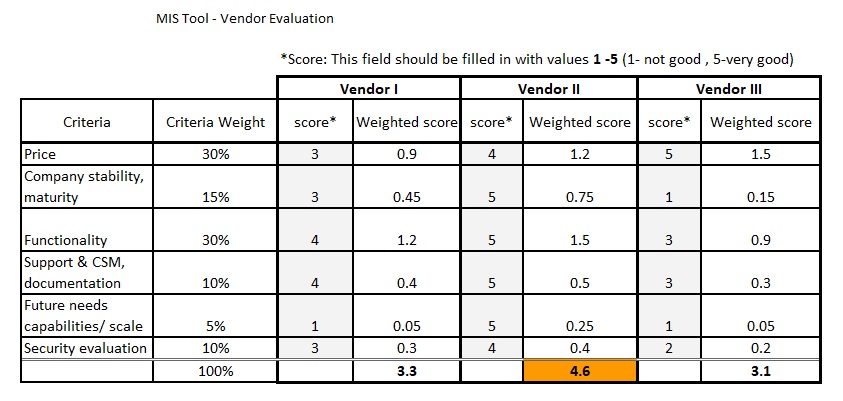Vendor Negotiation 101: A Step By Step Guide

Without even realizing it, you are negotiating all the time. At home, at work, with family, friends and just about everyone you interact with. Perhaps you tell your child, “Eat your vegetables, and then you can have your dessert.” That’s negotiation. Or, you say to your boss, “I’ve worked hard this year, I would like a bonus!”. You even negotiate with your pets – “Get off the couch, or…”
If you negotiate with vendors at work, you need to develop a skill set that goes way beyond vegetables versus dessert. You need to call on sophisticated negotiation skills to reach your business goals while receiving the quality you expect within a budget. Achieving these skills requires practice, and a certain mindset that is not difficult to cultivate with the right tools. How? We’re here to help.
Here’s our step-by-step guidelines for successful vendor negotiation:
Step 1: Start by researching
Before you begin any negotiation, you’d better make sure you’ve got your information straight. This is going to require some research on your part, including a deep understanding of what you need, and what’s available. Take a look at this checklist to make sure you’ve got all the data at your fingertips:
- Write a detailed specification of what you need – the more details, the better!
- Explore the different options in the market. Is there only one suitable provider? Or are there a few you could choose from?
- Who will be the users/participants of the product or service?
- Who are the stakeholders? They will help you define how urgent and important the procurement is, and what kind of budget you are working with. Make sure that all stakeholders approve the needs specification, and include them in the sourcing process.
- Define an ROI for the purchase. Then you’ll have a clear idea of what you are aiming for.
Step 2: Know who you’re talking to
You can only connect effectively with vendors when you know who they are and what they are all about. Before jumping into negotiations, learn all you can about the provider. How long have they been in business? Who are their clients? What are their success stories? Does the vendor have a track record of dependability? Find out whether you’ll be meeting with a sales rep or with the company owner. Check out the background of the contact person, via LinkedIn and other social platforms. Get in touch with their past and current clients, and see what they have to say about the company and its product/service. And of course you should search online for feedback and reviews – the more you find out, the better!
Step 3: Benchmarking is your best friend
Benchmarking is a vital step to make sure you know exactly what the vendor is offering and how it stacks up against other options in the market. Wherever possible, run the negotiation with more than one provider. You want to keep your options as wide as possible from the start.
Compare the vendors’ product or service offerings, including the warranty and SLA. Use a scoring analysis so you can make a data-based decision that will objectively be the right one. You can choose whatever benchmarks you need to best evaluate your vendors, depending on the type of product or service they provide. Here’s an example of the kind of scoring analysis I often use to evaluate vendors:

Another way to benchmark is to search online for pricing. You can get quite a lot of information that way, but make sure you always compare apples to apples. Define the unit of measure – then you’ll be making accurate comparisons.
If you are looking at a global service, check the impact on taxes, including VAT and sales taxes. These can significantly ramp up the cost (and, as the saying goes, “the devil is in the details.”)
The process of benchmarking is an analytical one, and it’s based on hard figures. But that doesn’t mean you should completely ignore your intuition. Instinct is a powerful thing – make sure you stay tuned in, while following all the rules of proper benchmarking.
Step 4: Go for the win-win
Now that you’ve researched, planned and benchmarked, it’s time to go face to face. Make sure you are well prepared for the meeting, and that means knowing what your red lines are – what is a “must” and what’s “nice to have”. Then you’ll be clear about how far you are willing to go.
Try to ascertain what the vendor wants to achieve. Is there a time limit to their offer? If you agree to the offer within a certain time frame, will they agree to better terms? Are they planning to scale their service plan over time? This might be an opportunity to consider your long term needs and try to secure discounts.
Stay lean, but be open to creativity. The structure of the offering may be different than what you expected, and it just may be possible to alter it to benefit both parties.
The win-win approach is also an important strategy to help you maintain positive long-term relationships with vendors. Even if you are planning a one-time procurement, you never know when you might come across this particular vendor again. It’s a small world after all, so make sure to stay on good terms with all the vendors you work with.
Step 5: Do what you can to reduce risk
The purpose of negotiation is to procure the best product or service at an optimal price. But an inherent part of the process is avoiding risks. Here are some examples of risks you should avoid:
- When procuring a new service: Avoid getting “stuck” with the wrong choice. Run a POC to allow you to check that the product fits your needs.
- When procuring a license: Keep your IT team or manager in the loop to avoid issues that may arise with integration, security, software updates, etc.
- When procuring agreements: Include your legal representative in the process to make sure you’ve got the professional contract language and terms covered.
- Termination terms: Make sure you can terminate the agreement if they don’t deliver. In some cases, there may be other relevant exit points. This applies mostly to hourly based services, but not only. Another important tip: Avoid auto renewals. This will prevent unwanted or unauthorized contract renewals.
- If you are working with one provider: Make sure to keep a constant eye on this engagement and monitor it closely – don’t risk your only vendor.
- Warranties, SLAs & KPIs: Keep these at the front of your mind. These enable you to measure performance so you can properly assess the quality of the service or product.
A Last Word Before Negotiations Begin…
Vendor negotiation is a bit like dating: first impressions count, make sure you “dress to impress”, and be on your best behavior while remaining true to yourself. Remember, you’re not just interacting with a vendor – there’s a person on the other side of the table, who has a family, hobbies and career goals. Try to see them as the individual they are, and bring yourself to the table too, so you can negotiate together with trust and openness.
At the same time, guard the interests of your company – there are some cards best kept hidden (i.e. your budget). Remember, it doesn’t hurt to ask (for more!). Stay focused on your end goal of getting the best product for the best terms. And finally, enjoy the negotiation; this will help to create a win-win environment so you can get it right.










